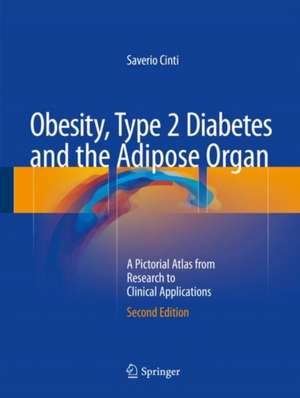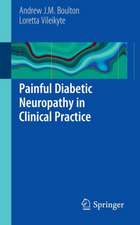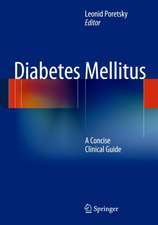Obesity, Type 2 Diabetes and the Adipose Organ: A Pictorial Atlas from Research to Clinical Applications
Autor Saverio Cintien Limba Engleză Hardback – 8 mar 2018
Preț: 838.04 lei
Preț vechi: 882.15 lei
-5% Nou
Puncte Express: 1257
Preț estimativ în valută:
160.38€ • 166.82$ • 132.40£
160.38€ • 166.82$ • 132.40£
Carte disponibilă
Livrare economică 24 martie-07 aprilie
Preluare comenzi: 021 569.72.76
Specificații
ISBN-13: 9783319405209
ISBN-10: 3319405209
Pagini: 271
Ilustrații: XIII, 455 p. 190 illus., 60 illus. in color.
Dimensiuni: 210 x 279 x 26 mm
Greutate: 1.89 kg
Ediția:2nd ed. 2018
Editura: Springer International Publishing
Colecția Springer
Locul publicării:Cham, Switzerland
ISBN-10: 3319405209
Pagini: 271
Ilustrații: XIII, 455 p. 190 illus., 60 illus. in color.
Dimensiuni: 210 x 279 x 26 mm
Greutate: 1.89 kg
Ediția:2nd ed. 2018
Editura: Springer International Publishing
Colecția Springer
Locul publicării:Cham, Switzerland
Cuprins
The Adipose Organ.- Brown Adipose Tissue (BAT).- White Adipose Tissue (WAT).- The Adipose Organ: Cold Acclimation.- BAT.- WAT.- The Adipose Organ: Warm Acclimation: BAT.- The Obese Adipose Organ: BAT.- The Fasted Adipose Organ: WAT.- BAT.- The Adipose Organ During Lactation: WAT.- BAT.- The Fetal Adipose Organ.- The Adipose Organ In Genetically Modified Models.
Notă biografică
Saverio Cinti, MD, graduated from the University of Padua, Italy, in 1974 and subsequently completed specializations in Internal Medicine (University of Verona) and Surgical Pathology (University of Milan). In 1986 he was appointed Full Professor of Human Anatomy at the University of Ancona. Dr. Cinti is currently President of the Obesity Center at the University of Ancona and Director of the Biology of Obesity Unit at United Hospitals of Ancona. He has also been a Visiting Professor at Harvard Medical School (Elio Raviola lab), Dana Farber-Harvard Medical School (Bruce Spiegelman Lab), and Copenhagen University (Karsten Kristiansen lab). From 2008 to 2010 Dr. Cinti was President of the Italian Society of Obesity. In 2008 he received the Blaise Pascal Medal from the European Academy of Sciences and in 2013, the Friedrich Wassermann Prize from the European Association for the Study of Obesity. In 2014 he was elected to present the EFEM (European Federation Experimental Morphology) le13000 citations (Scopus Aug 2015 ID 7004604501).
Textul de pe ultima copertă
This richly illustrated book provides a detailed description of the gross anatomy, light microscopy, immunohistochemistry, and electron microscopy of the adipose organ, which comprises subcutaneous and visceral fat depots. Findings in mice of differing genetic backgrounds (obesity prone and resistant) and maintained in standard and various physiologic and pathologic conditions are presented. The latter conditions include chronic cold exposure, warm exposure, fasting, pregnancy–lactation, and obesity. Features of the fetal adipose organ are described in a separate chapter, and results from transgenic mice are also presented when relevant. The human adipose organ is addressed in several chapters that include magnetic resonance and fetal findings. Most of the results regarding the adipose organ anatomy in different physiologic conditions are new, and the story of pink adipocytes (white-to-pink transdifferentiation) is quite innovative. The concept of using browning of the adipose organ as a therapeutic tool for obesity must take into consideration the anatomic and morphologic aspects described here, and the study of pink adipocytes could lead to a better comprehension of breast cancer tumor biology. This book will be of interest to all scientists who deal with obesity and related disorders.
Caracteristici
Describes anatomic and morphologic aspects of adipose tissues relevant to obesity therapy Presents new results regarding adipose organ anatomy in different physiologic conditions Introduces white-to-pink transdifferentiation of adipocytes and its implications









